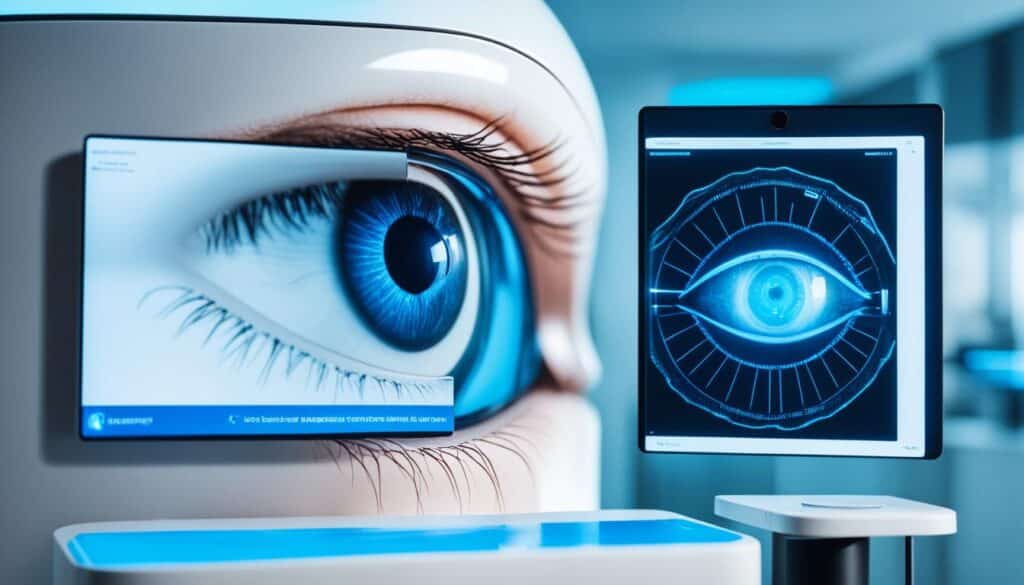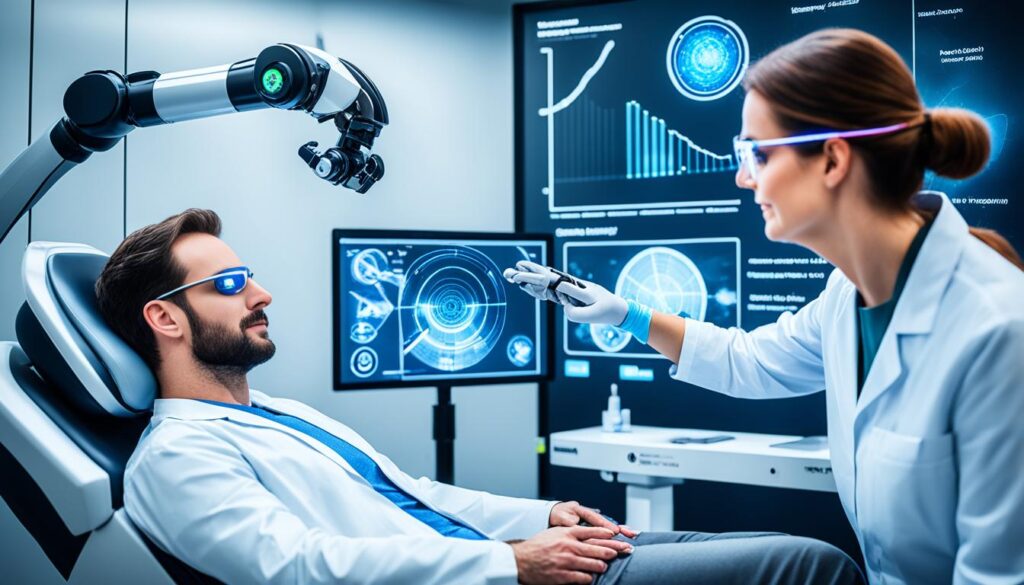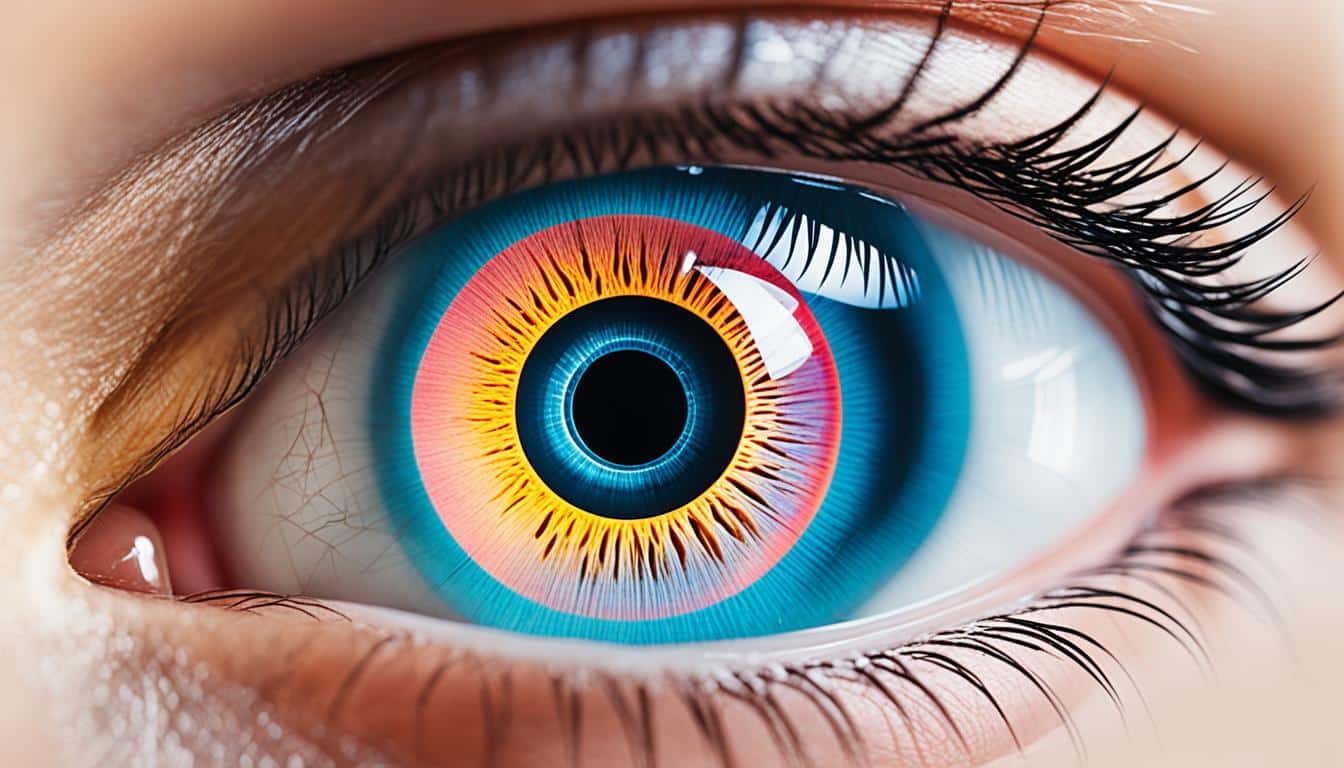Welcome to our comprehensive guide on the exciting advancements shaping the field of ophthalmology. In this article, we will delve into the emerging trends and cutting-edge techniques that are revolutionizing eye care. From the utilization of artificial intelligence (AI) in diagnostics to groundbreaking treatment advancements, we will explore the transformative impact these developments have on the way we diagnose and treat various eye diseases.
Ophthalmology, a branch of medicine specializing in eye health, is witnessing remarkable progress through the integration of AI diagnostics and treatment innovations. These emerging technologies not only enhance patient care but also open new avenues for research and development in this field. By staying informed about the latest trends and techniques, healthcare professionals can provide the best possible treatments and preventive measures for their patients, ensuring optimal outcomes.
Key Takeaways:
- Ophthalmology is experiencing unprecedented advancements in diagnostics and treatment techniques.
- Artificial intelligence (AI) plays a pivotal role in the emerging trends and future directions of eye care.
- Retinal imaging, diagnostics, and AI models offer new possibilities for early detection and improved prognosis of retinal diseases.
- Revolutionary treatments, including AI applications and gene therapies, are transforming the management of common eye diseases.
- AI integration in cataract surgery ensures better surgical outcomes, patient safety, and efficacy.
The Role of AI in Ophthalmology
Artificial intelligence (AI) is revolutionizing the field of ophthalmology, offering new possibilities for diagnosing and treating eye diseases. With its advanced capabilities, AI has the potential to enhance patient outcomes and reshape the future of eye care.
AI is being utilized in various aspects of ophthalmology, particularly in diagnostics. By analyzing large datasets and images, AI algorithms can accurately detect eye diseases such as glaucoma, diabetic retinopathy, and age-related macular degeneration, enabling early intervention and preventing irreversible vision loss.
In addition to diagnostics, AI is also improving treatment advancements in ophthalmology. Machine learning algorithms can analyze patient data and customize treatment plans, taking into account individual characteristics and improving efficacy. This personalized approach optimizes patient care and enhances treatment outcomes.
The integration of AI in ophthalmology is not limited to clinical practice but also extends to research and development. AI models can analyze vast amounts of data, accelerating the discovery of new treatments and enhancing our understanding of eye diseases. This has the potential to drive innovation and lead to groundbreaking advancements in the field.
“Artificial intelligence offers new possibilities for diagnosing and treating eye diseases, enhancing patient outcomes and reshaping the future of eye care.”
The future of eye care holds immense potential with AI at its forefront. As technology continues to evolve, AI is expected to play a vital role in improving patient care, optimizing treatment plans, and enabling early intervention for better outcomes. With ongoing research and development, we can anticipate even more sophisticated AI applications that will revolutionize ophthalmology.
Advantages of AI in Ophthalmology:
- Accurate and early detection of eye diseases
- Personalized treatment plans based on individual characteristics
- Enhanced patient outcomes and improved safety
- Acceleration of research and development in the field
- Increased accessibility to eye care in remote areas
As AI continues to advance, it is essential for ophthalmologists and eye care professionals to stay up-to-date with the latest developments in this rapidly evolving field. By embracing and harnessing the power of AI, we can transform the way eye diseases are diagnosed, treated, and managed, ultimately improving the quality of life for patients.
| Advantages of AI in Ophthalmology | |
|---|---|
| Accurate and early detection of eye diseases | |
| Personalized treatment plans based on individual characteristics | |
| Enhanced patient outcomes and improved safety | |
| Acceleration of research and development in the field | |
| Increased accessibility to eye care in remote areas |
Advancements in Retinal Imaging and Diagnostics
Retinal imaging and diagnostics have undergone remarkable advancements in recent years, revolutionizing the field of ophthalmology. These advancements are made possible by cutting-edge technologies such as Optical Coherence Tomography (OCT) and Artificial Intelligence (AI) models. By combining these innovative tools, ophthalmologists can now diagnose and treat retinal diseases with greater precision and accuracy.
OCT, a non-invasive imaging technique, allows ophthalmologists to capture high-resolution images of the retina, providing invaluable insights into its structure and detecting early signs of retinal disease. This technology uses light waves to create cross-sectional images of the retina, enabling clinicians to identify abnormalities and monitor disease progression.
The integration of AI models in retinal imaging and diagnostics has further enhanced the capabilities of OCT. AI algorithms analyze OCT images and identify patterns and abnormalities that may be imperceptible to the human eye. By leveraging vast datasets and machine learning, AI models can detect and predict the presence of retinal diseases, such as diabetic retinopathy and age-related macular degeneration. This early detection facilitates prompt intervention, leading to improved prognosis and better patient outcomes.
Advancements in retinal imaging and diagnostics, powered by OCT and AI models, have transformed the landscape of ophthalmology. These technologies provide ophthalmologists with a deeper understanding of retinal diseases and enable tailored treatment plans for their patients.
Furthermore, AI models can also assist ophthalmologists in the analysis and interpretation of retinal images. By automating the detection and classification of retinal diseases, AI algorithms help reduce the subjectivity and variability of human interpretation. This not only saves time but also enhances diagnostic accuracy, allowing for more efficient and personalized patient care.
Role of AI in Diagnosing Retinal Diseases
The use of AI in diagnosing retinal diseases is particularly beneficial in cases where specialized expertise may be scarce. AI models can be trained on large datasets of retinal images, enabling them to accurately identify various conditions, including retinal detachments, retinopathy of prematurity, and retinitis pigmentosa, among others.
By automating the diagnosis process, AI models can help to overcome geographical barriers and improve access to specialized care. This technology has the potential to revolutionize global eye health, ensuring that patients receive timely and accurate diagnoses regardless of their location.
Potential for Early Detection and Improved Prognosis
Early detection of retinal diseases plays a crucial role in preventing irreversible vision loss and preserving patients’ quality of life. With the integration of AI in retinal imaging and diagnostics, ophthalmologists can identify subtle changes in the retina that may indicate the presence of disease.
By leveraging AI algorithms, ophthalmologists can detect retinal diseases at their earliest stages, allowing for timely intervention and tailored treatment plans. This proactive approach can significantly improve patient outcomes and increase the chances of preserving vision.

| Advancements in Retinal Imaging and Diagnostics | Benefits |
|---|---|
| OCT technology | Provides high-resolution images of the retina, aiding in the early detection and monitoring of retinal diseases. |
| AI models | Enhances diagnostic accuracy, assists in the interpretation of retinal images, and automates the detection of retinal diseases. |
| Early detection | Enables timely intervention, personalized treatment plans, and improved prognosis for patients. |
The advancements in retinal imaging and diagnostics, driven by OCT and AI models, have revolutionized ophthalmology. By harnessing the power of these technologies, ophthalmologists can provide more accurate diagnoses, implement timely interventions, and offer personalized treatment plans for retinal diseases. This integration of technology holds great promise for the future of ophthalmology, improving patient outcomes and preserving vision.
Revolutionary Treatments for Common Eye Diseases
Advancements in ophthalmology have paved the way for revolutionary treatments for common eye diseases, including glaucoma, cataract, diabetic retinopathy, and genetic eye diseases. With the integration of AI applications and innovative techniques, patient care is being elevated to new heights, significantly improving treatment outcomes.
Let’s delve into some of these groundbreaking advancements:
Glaucoma: Enhancing Precision and Early Detection
Glaucoma affects millions of people worldwide and is a leading cause of irreversible vision loss. With AI applications, ophthalmologists now have powerful tools to aid in precise diagnosis and treatment planning. AI algorithms can analyze complex data from imaging tests, such as optical coherence tomography (OCT) scans, to detect subtle changes in the optic nerve and provide early warnings of glaucoma development. By enabling early detection and intervention, AI is helping to preserve vision and improve patient outcomes.
Cataract: Personalized Surgical Planning and Enhanced Visual Clarity
Cataract surgery is one of the most common procedures in ophthalmology. Through AI applications, surgeons can now leverage advanced imaging and measurement techniques to plan personalized surgeries tailored to each patient’s unique eye characteristics. This precision surgery approach, combined with the use of sophisticated intraocular lens (IOL) technologies, enables better postoperative visual outcomes and improved overall satisfaction for cataract patients.
Diabetic Retinopathy: Early Detection and Prevention
Diabetic retinopathy is a complication of diabetes that can lead to vision loss if left untreated. AI algorithms have revolutionized the screening and detection of diabetic retinopathy by analyzing retinal images to identify early signs of the disease. With timely detection, patients can receive prompt treatment, preventing further progression and minimizing the risk of severe vision impairment or blindness.
Genetic Eye Diseases: Unleashing the Potential of Gene Therapies
Genetic eye diseases, such as retinitis pigmentosa and Leber congenital amaurosis, have long posed significant challenges in ophthalmology. However, recent breakthroughs in gene therapies are offering new hope for patients with these conditions. By utilizing AI-driven gene sequencing and CRISPR technologies, researchers are gaining a deeper understanding of genetic mutations and developing targeted treatments to correct or mitigate the effects of these mutations, potentially restoring vision in individuals affected by genetic eye diseases.
These remarkable advancements in the treatment of glaucoma, cataract, diabetic retinopathy, and genetic eye diseases represent the cutting edge of ophthalmology. With AI applications and innovative techniques at the forefront, patient care is being transformed, providing new opportunities for early detection, personalized treatments, and improved outcomes.
The Impact of AI in Cataract Surgery
Cataract surgery, one of the most common procedures in ophthalmic practice, has witnessed significant advancements with the integration of artificial intelligence (AI) systems. These cutting-edge technologies are revolutionizing surgical techniques, enhancing patient outcomes, and ensuring the safety and efficacy of cataract surgeries.
By harnessing the power of AI, ophthalmologists can now rely on intelligent systems that assist and augment their surgical skills. AI systems analyze preoperative data, such as biometry measurements and ocular images, to provide accurate predictions and recommendations for surgical planning.
The integration of AI systems in cataract surgery has resulted in several key benefits. First, these systems enable precise intraocular lens (IOL) selection, taking into account various factors such as the patient’s age, ocular anatomy, and visual needs. This personalized approach ensures optimal visual outcomes and enhances patient satisfaction.
The incorporation of AI algorithms into cataract surgery has revolutionized patient care by streamlining the surgical process and providing clinicians with valuable insights and recommendations.
Intraoperatively, AI systems guide surgeons with real-time feedback, helping them make critical decisions during the procedure. This technology assists in achieving precise incisions, effective phacoemulsification, and optimal IOL placement. Surgeons can rely on the system’s recommendations for accurate positioning of the IOL, minimizing refractive errors and enhancing postoperative visual acuity.
Additionally, AI systems enhance patient safety during cataract surgery. By continuously monitoring surgical parameters and alerting surgeons to potential complications, these systems contribute to the early detection and prevention of adverse events. This proactive approach improves patient safety and reduces the risk of complications, ultimately leading to better patient outcomes.
Improving Surgical Outcomes with AI
Research has shown that the integration of AI systems in cataract surgery significantly improves surgical outcomes. Studies have demonstrated enhanced refractive predictability, reduced refractive errors, and improved visual acuity compared to traditional manual techniques.
Moreover, AI systems offer valuable data for postoperative analysis and quality improvement initiatives. By aggregating and analyzing surgical data, these systems enable surgeons to identify trends, evaluate their techniques, and implement refinements to further optimize patient outcomes.
The impact of AI in cataract surgery extends beyond the operating room. These technologies contribute to the advancement of knowledge in the field by enhancing data-driven research and fostering collaboration among ophthalmologists worldwide.
With the integration of AI systems, cataract surgery has evolved into a more precise and personalized procedure, resulting in improved patient outcomes, enhanced safety, and increased surgical efficiency. The future of cataract surgery lies in the collaborative synergy between surgeons and intelligent AI algorithms, ensuring optimal visual outcomes for patients undergoing this transformative procedure.

AI Applications in Clinical Practice and Research
In the field of Ophthalmology, the utilization of AI applications in clinical practice and research has proven to be a game-changer. From enhancing diagnostic accuracy to facilitating breakthroughs in treatment options, AI is revolutionizing patient care and driving advancements in this specialized area of medicine.
One of the key areas where AI is making a significant impact is in the analysis of patient data. Through the power of deep learning models, ophthalmologists can now extract valuable insights from vast amounts of patient data, leading to improved diagnoses and personalized treatment plans. By using AI algorithms to detect patterns and abnormalities, healthcare professionals can make well-informed decisions based on comprehensive and objective data analysis.
AI’s contributions go beyond clinical practice and extend to research and development. With its ability to analyze complex datasets and identify hidden correlations, AI is facilitating groundbreaking research that pushes the boundaries of ophthalmology. This innovative technology enables researchers to uncover new knowledge, develop novel treatment approaches, and unlock the potential for improved patient outcomes.
AI’s ability to analyze patient data and contribute to research in ophthalmology is paving the way for transformative advancements in the field.”
Furthermore, AI is streamlining the process of clinical trials, making them faster and more efficient. By leveraging AI applications, researchers can identify suitable candidates, monitor treatment progress, and analyze trial outcomes with greater speed and accuracy. This not only accelerates the development of new therapies but also ensures that patients receive the most effective treatments available.
It is worth noting that the integration of AI in clinical practice and research requires stringent adherence to privacy and ethical considerations. Safeguarding patient data and ensuring its secure usage are essential priorities when implementing AI technologies. By adhering to strict guidelines and regulations, healthcare professionals can harness the power of AI while maintaining patient confidentiality and trust.
As AI continues to evolve, its potential for innovation in ophthalmology shows no signs of slowing down. From leveraging machine learning algorithms to extract insights from big data to transforming the way clinical trials are conducted, AI is at the forefront of technological advancements in this field.
AI Applications in Ophthalmology: Summary
| Benefit | Impact |
|---|---|
| Enhanced diagnostic accuracy | Improvements in patient diagnoses and personalized treatment plans. |
| Groundbreaking research | Uncovering new knowledge, developing novel treatment approaches, and improving patient outcomes. |
| Streamlined clinical trials | Accelerating the development of new therapies and ensuring patients receive the most effective treatments. |
| Ethical considerations | Safeguarding patient data and maintaining confidentiality and trust in the implementation of AI technologies. |
With the ongoing advancements in AI applications, ophthalmology is entering an era of unprecedented possibilities. By harnessing AI’s potential, healthcare professionals and researchers are poised to provide enhanced patient care, drive innovative research initiatives, and transform the future of eye healthcare.

Explore the emerging trends and possibilities in ophthalmology in the next section of this informative series.
Emerging Trends and Future Directions in Ophthalmology
As the field of Ophthalmology continues to evolve, staying informed about emerging trends and future directions is crucial for healthcare professionals. These advancements have the potential to revolutionize eye care and significantly improve patient outcomes. The integration of research and development initiatives with breakthrough technologies such as AI is propelling the field forward with exciting possibilities.
Also Read : Effective Medical Treatments Options in the US
One of the key areas seeing rapid growth is the application of AI in ocular diagnostics and treatment. By harnessing the power of deep learning algorithms, AI systems can analyze vast amounts of patient data to provide accurate diagnoses and personalized treatment plans. This technology has the potential to enhance efficiency, speed up diagnoses, and improve overall patient care.
Furthermore, regenerative medicine is an exciting frontier in the field. Stem cell therapies and genetic engineering techniques are being explored to develop innovative treatments for various eye diseases. By targeting the root cause of these conditions, researchers hope to provide long-term solutions that not only alleviate symptoms but also prevent disease progression.
“The future of ophthalmology lies in the integration of cutting-edge technologies and ongoing research and development. This convergence has the potential to transform how we diagnose and treat eye diseases, making personalized medicine a reality.” – Dr. Sarah Evans, Ophthalmologist
Moreover, advancements in imaging technologies are revolutionizing the way clinicians visualize and analyze eye structures. Technologies like Optical Coherence Tomography (OCT) are providing high-resolution images of the retina, enabling the early detection and monitoring of retinal diseases. This precise imaging capability, combined with AI algorithms, is paving the way for more accurate and efficient diagnoses.
The future of ophthalmology also involves exploring innovative surgical techniques. From robotic-assisted surgeries to nanotechnology applications, these advancements aim to enhance surgical precision, minimize invasiveness, and improve patient outcomes. By embracing these emerging trends, ophthalmologists can provide patients with state-of-the-art care.

Future Directions
Looking ahead, the continued collaboration between ophthalmology and other medical specialties will result in novel research and treatment discoveries. The use of big data analytics and AI in research will allow for more comprehensive insights into eye diseases and facilitate the development of targeted therapies.
Ongoing efforts in telemedicine are also expected to play a pivotal role in the future of eye care. Remote consultations and monitoring will improve accessibility to specialized care, particularly in underserved areas. Patients will benefit from timely diagnoses and efficient management of their eye conditions, regardless of their geographical location.
As the field of ophthalmology continues to embrace emerging trends and future directions, patients can expect better outcomes, enhanced accessibility to care, and the potential for groundbreaking treatments. By staying abreast of these developments, healthcare professionals can provide the highest level of care and ensure the preservation of their patients’ precious gift of sight.
| Emerging Trends and Future Directions in Ophthalmology | |
|---|---|
| Integration of AI in ocular diagnostics and treatment | Advances in imaging technologies for accurate diagnoses |
| Regenerative medicine for innovative eye disease treatments | Exploration of novel surgical techniques |
| Collaboration between ophthalmology and other specialties | Utilization of big data analytics and AI in research |
| Emergence of telemedicine for improved accessibility to care |
Addressing Myopia and Refractive Surgery with AI
Myopia, a common eye disorder, and refractive surgery have witnessed significant advancements with the integration of AI applications. By harnessing the power of artificial intelligence, ophthalmologists can now enhance the accuracy of surgical interventions and assess visual function more effectively, leading to optimal outcomes for patients with myopia and those undergoing refractive surgeries.
One of the key areas where AI proves invaluable is in improving the precision of refractive surgery procedures. By utilizing AI algorithms and sophisticated imaging technology, ophthalmologists can map and analyze the cornea more accurately, enabling them to tailor surgical interventions precisely to the patient’s unique requirements. This personalized approach enhances surgical outcomes and boosts patient satisfaction.
Moreover, AI applications play a crucial role in assessing visual function before and after myopia and refractive surgeries. By implementing advanced AI models, ophthalmologists can evaluate visual acuity, contrast sensitivity, and other parameters to gain comprehensive insights into a patient’s visual capabilities. This data helps guide treatment decisions and aids in monitoring post-operative progress, ensuring optimal visual outcomes.
The integration of AI in addressing myopia and refractive surgery not only improves surgical accuracy but also enhances safety. AI-powered diagnostic tools enable ophthalmologists to identify and mitigate potential risks or contraindications before the surgical procedure, minimizing the chances of complications and optimizing patient safety.
Furthermore, AI applications can assist ophthalmologists in predicting post-operative visual outcomes, enabling them to set realistic expectations for patients undergoing myopia and refractive surgeries. By utilizing patient-specific data and machine learning algorithms, AI models can provide insights into the expected visual improvements, enhancing the patient’s understanding and satisfaction throughout the treatment journey.
As AI continues to evolve and integrate further into ophthalmology, the advancements in addressing myopia and refractive surgery hold immense promise for improving patient outcomes and revolutionizing the field of ophthalmic surgery. The integration of AI applications in these areas enables ophthalmologists to achieve greater precision, enhance safety, and provide patients with optimized visual function, transforming the way we address myopia and refractive disorders.

| Advantages of AI in Myopia and Refractive Surgery |
|---|
| Enhanced accuracy of surgical interventions |
| Precise mapping and analysis of the cornea |
| Personalized surgical approaches |
| Improved assessment of visual function |
| Identification and mitigation of risks |
| Prediction of post-operative visual outcomes |
Innovations in Dry Eye Disease Management
Dry eye disease is a common condition that affects millions of people worldwide, causing discomfort and impacting eye health. Fortunately, advancements in ophthalmology and the integration of AI diagnostics have led to significant innovations in the management of dry eye disease.
To effectively diagnose and treat dry eye disease, ophthalmologists now utilize cutting-edge techniques that leverage AI technology. AI diagnostics play a crucial role in accurately identifying the condition, enabling targeted treatment plans tailored to individual patients.
The use of AI in dry eye disease management has revolutionized patient care by providing ophthalmologists with valuable insights into the underlying causes and contributing factors. Through the analysis of extensive patient data, AI algorithms can identify patterns and correlations that aid in the development of personalized treatment strategies.

These innovations in AI diagnostics have also led to a deeper understanding of the impact of dry eye disease on overall eye health. Ophthalmologists can now assess not only the ocular surface but also factors such as tear film stability and blink dynamics to provide comprehensive care.
By combining AI insights with traditional treatment methods such as artificial tears, lifestyle modifications, and therapeutic interventions, ophthalmologists can now offer patients more effective and targeted solutions for managing dry eye disease. This integrated approach to care improves both the short-term relief and long-term management of the condition.
Moreover, the advancements in dry eye disease management extend beyond the clinical setting. With an increased emphasis on patient education and support, individuals suffering from dry eye disease can better understand and manage their condition on a daily basis. Ophthalmologists play a vital role in empowering patients to actively participate in their own eye health, promoting a holistic approach to care.
| Treatment Methods | Benefits |
|---|---|
| Artificial tears and lubricants | Relief from dryness and discomfort |
| Lifestyle modifications (e.g., avoiding dry environments) | Reduced symptoms and improved tear film stability |
| Therapeutic interventions (e.g., punctal plugs) | Enhanced tear film retention and increased ocular surface moisture |
As dry eye disease management continues to evolve, ongoing research and development aim to further enhance patient care and optimize treatment outcomes. The integration of AI diagnostics and a patient-centered approach ensure that individuals with dry eye disease receive the highest standard of care, promoting improved eye health and overall well-being.
The Future of Ophthalmology: Integrating AI for Enhanced Eye Care
Gaining insights into the future of eye care is crucial for ophthalmologists and primary care providers. The integration of AI technologies in ophthalmology has the potential to revolutionize the field, leading to enhanced treatment outcomes and improved patient care. Let’s explore the ongoing advancements and research that are shaping the future of ophthalmology.
The Potential of AI Integration
Integrating AI into ophthalmology opens up a world of possibilities for treatment advancements and patient outcomes. AI algorithms can analyze vast amounts of medical data, helping ophthalmologists make more accurate diagnoses and personalized treatment plans. By combining the expertise of healthcare professionals with AI technologies, the future of eye care holds promise for improved precision, efficiency, and effectiveness.
Enhancing Treatment Outcomes
The integration of AI can significantly enhance treatment outcomes in ophthalmology. AI-powered systems can assist in real-time intraoperative decision-making during complex procedures, such as cataract surgeries, improving surgical accuracy and patient safety. By leveraging AI’s predictive capabilities, ophthalmologists can provide tailored treatment interventions, maximizing the chances of successful outcomes and minimizing potential risks.
Improving Patient Care
Incorporating AI into ophthalmology practice can also lead to improved patient care. With AI-enabled tools, ophthalmologists can streamline patient management and optimize workflows, enabling more efficient and timely diagnoses and treatments. AI algorithms can analyze patient data, identify patterns, and recommend personalized care plans, ensuring patients receive the most appropriate and effective interventions for their unique needs.
Unveiling Invaluable Insights
“Integrating AI technologies into ophthalmology holds the promise of unveiling invaluable insights into eye diseases and their treatments. By leveraging vast datasets and advanced machine learning algorithms, AI can help researchers better understand the underlying mechanisms of ocular conditions and develop novel therapeutic strategies.”
Continual Advancements and Research
The integration of AI in ophthalmology is an ever-evolving field, with ongoing advancements and research fueling its growth. Researchers are working to refine AI algorithms, improve diagnostic accuracy, and explore new applications to address a wide range of eye diseases. As technology advances, the future of ophthalmology holds the potential for groundbreaking discoveries and innovative solutions that will shape eye care for years to come.
As we move forward, the integration of AI in ophthalmology will continue to be a driving force behind treatment advancements, patient outcomes, and the overall future of eye care. The collaboration between technology and medical expertise will unlock new possibilities to improve the lives of individuals with eye conditions and ensure better visual health for all.
Conclusion
The field of ophthalmology is continuously evolving, thanks to remarkable advancements in diagnostic techniques, treatment options, and research and development. With the integration of AI and other cutting-edge technologies, the future of eye care holds immense promise.
These advancements offer the potential to improve patient outcomes and prevent irreversible vision loss. From AI diagnostics to innovative treatment approaches, ophthalmologists have an array of tools at their disposal to provide the best possible care for their patients.
Staying informed about the latest trends and innovations is crucial in this dynamic field. By keeping up with the ongoing research and developments, ophthalmologists can enhance their expertise and ensure they are providing the most advanced and effective treatments available.
As we move forward, the future of eye care will continue to be shaped by research and development in ophthalmology. By embracing technological advancements and staying proactive in expanding their knowledge, ophthalmologists play a critical role in improving patient outcomes and advancing the field of eye treatment.





